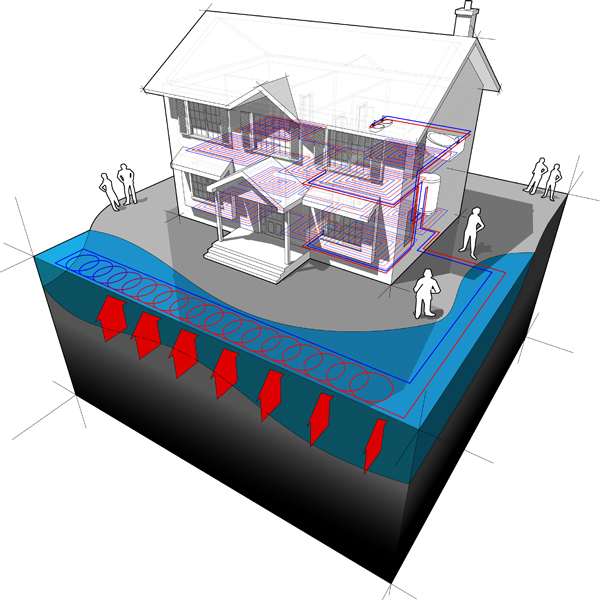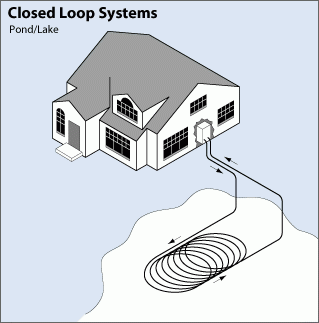
Water source heat pumps (WSHPs) are not commonly deployed in the United States but offer a feasible alternative to air-source and strictly geothermal options. They transfer heat from a body of water (lake, river, pond, aquifer) into a building space by way of a heat pump and are structurally very similar to geothermal heat pump systems that extract heat from the subsurface. In fact, water-source systems use the same heat pump units as geothermal systems, the only major difference being the thermal energy source (the ground vs body of water).
There are two types of WSHP systems: Closed (Figure 1) and open loop (Figure 2). Closed loop systems consist of submerged sealed pipes containing a heat-transfer fluid, such as a refrigerant, which pulls and collects heat from the water. That heat is then transferred into a building by means of a heat pump. In warmer months, this same system works in reverse; heat is extracted from a building and dumped into the body of water to cool the space.
Figure 1: Closed Loop Water Source Heat Pump System

Source: US Dept of Energy, Energy Saver
Throughout the process, the refrigerant never comes into direct contact with the water itself, and the system is not exposed to the surface elements. As such, it faces a low risk of freezing and minimal maintenance requirements. To be effective, a suitable body of water should be nearby, and minimum water quality, volume, and depth requirements must be met.
Figure 2: Open Loop Water Source Heat Pump System

Source: US Dept of Energy, Energy Saver
Conversely, open loop systems do not use refrigerant but water as the heat transfer fluid. In this case, subsurface water (surface body water/aquifer) is filtered into a pipe in one location through a borehole to a heat exchanger, after which the cooler water is returned to a more distant location through a second borehole.
Certain requirements must be met to install an open loop WSHP. The body of water must have a high enough capacity to heat or cool a building — a flow rate of 1.5 gallons per minute is the baseline, with a higher flow necessary in colder months when water temperatures fall, to prevent freezing. Water pH and mineral content also need to be measured before installation to ensure chemical components of the water do not damage installed equipment. As such, this option is most feasible when there is an adequate supply of relatively clean water near the building.
Areas around the Great Lakes are perfectly suited for water source heat pump systems, especially for large-scale district cooling. District cold water cooling works with heat exchangers that transfer thermal energy from a source of cold water between 4- and 10-degrees Celsius acting as a heat sink — generally from the depths of a lake. The coolness of the water itself traveling through a series of pipes dissipates heat from buildings and effectively air conditions them.
For example, the city of Toronto, Canada has been expanding its deep lake water cooling system. This system pumps cold water from Lake Ontario to consumers in the city through three large pipes and efficiently air conditions nearly 100 buildings in Toronto’s downtown. Participating buildings experience energy savings between 70 and 80 percent compared to buildings using traditional cooling systems.
Similarly, Cornell University in upstate New York has developed an open loop district cooling system, which serves 85 percent of cooling demand for both the campus and neighboring high school.
These large district cooling systems are environmentally and economically efficient, in terms of providing cooling services for a whole community and offering flexibility for individual buildings. While uncommon, water source heat pumps are an efficient, climate-friendly option for those that have access to proper sources of water.



